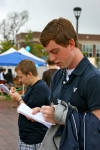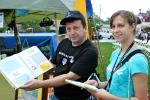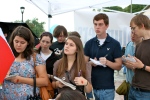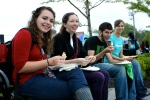-
Search It!
-
Recent Entries
-
Links
Bobby’s Idle Hour mini-documentary
Hot off the press! Here’s the mini-doc we finished last night. Thanks to Dianne Herald of Bobby’s Idle Hour and all the musicians from Writer’s Night for your help!
Posted in Uncategorized
Attending multimedia boot camp
I’m here in Nashville for the next few days at the Freedom Forum Diversity Institute for an advanced multimedia boot camp. I know, you’re thinking, “How did she get in the advanced class?” I’m no expert; it’s only because I took the basic class in November. Last time, I learned to record and edit audio and video, using the editing programs Audacity, Soundslides and Final Cut Pro.
Our assignment this time was to document one of Nashville’s favorite honky tonks, Bobby’s Idle Hour, and produce a three- to five-minute mini-documentary. Stay tuned!
Posted in Uncategorized
Using iPhones in class
I’m taking part in Western Kentucky University’s experimental program to use iPhones in the classroom. I got a new iPhone out of the deal – lucky me! WKU gets a bunch of instructors who pledge to find ways to bring this mobile technology into the classroom.
For journalists, iPhones and similar devices provide a fast, easy way to do reporting. Need a quick photo? Check. A brief video? Check. Record an interview? Check. All of it is e-mailable from the field, making a quick turnaround possible. (Oh, and it also makes phone calls.)
My class got a taste of this versatility last week, when new multimedia faculty member Kerry Northrup led a podcasting workshop for us. I encouraged students who had iPhones to use them to record their audio. The student paper did a story about the experience.

Photo by the Herald
Since I received my iPhone about two months ago, I’ve used it to record video, audio and photos to upload to blogs and for freelance assignments. The quality of the media seems pretty good, although it’s not be equal to equipment designed for each individual task.
Some universities now require journalism students to bring mobile devices such as iPhones to school with them. I don’t think WKU is ready for that step, but clearly more and more journalists will find themselves using these technologies in a changing workplace.
The gullible media?
What gives lately with these hoaxes?
First, the wild ride of a Colorado “balloon boy” believed trapped in a runaway helium balloon turned out to be nothing more than a publicity stunt. Live media coverage of the spectacle attracted millions of concerned viewers before the local sheriff deemed the event a hoax.
Then today comes word that several media organizations fell for a fake news release announcing that the U.S. Chamber of Commerce purportedly dropped its longstanding opposition to climate change legislation. MSNBC reported the release live as breaking news, and Reuters news service filed a wire brief that several other publications picked up. The outfit behind the prank was the Yes Men, a renegade group of pranksters bent on poking corporate American in the eye.
The media have been taken in by hoaxes before and sometimes even perpetrated them.
How do we avoid this? For starters, good journalists should always verify press releases and Web site information before publishing. Secondly, journalists should seek multiple sources of information. And of course, journalists should approach all potential stories with a critical eye.
But in the case of the balloon boy, should the media have treated this “news event” with more skepticism, to the point of declining to cover the event until it was a confirmed emergency? Or were they right to simply follow the story wherever it led — even if that was over 60 miles of Colorado fields?
Posted in Journalism ethics
Follow me at SEJ!
I’m in Madison, Wisc. attending the Society of Environmental Journalists’ annual conference. I’ve been blogging for the official conference blog.
Today I blogged about a tour to the Crave Brothers dairy farm, a 1,000-cow operation with its own cheese-making business. Tonight I met an organic dairy farmer who lives near the Crave Brothers and filed another post about his perspective on farming. The two farms provided an interesting contrast. Both are innovative, yet different in their approaches.

You can read these posts and follow all my posts from SEJ at this link. Follow the entire SEJ conference blog here at http://sej2009.sej.org/.
Posted in Uncategorized
Covering the International Festival
My students and I attended the Bowling Green International Festival Sept. 26. They scurried around interviewing people for a class reporting and writing assignment, and I followed after them documenting their work. Despite the rainy weather and a first-time admission fee of $3, residents of Bowling Green turned out for what has become a favorite fall cultural activity. Here are a few photos of my students working hard:
Lessons from diversity seminar
Last Friday, I attended seminar at Western Kentucky University on diversity and excellence in journalism, taught by Keith Woods of Poynter Institute. Keith did a great job, and I’m not just saying that because we are longtime friends. (Keith was my very first real newspaper editor, when I was still a college student, way back at The Times-Picayune in New Orleans.)
Most of us understand the need for “diversity,” at least on a superficial level. But in this seminar, I learned several different ways of thinking about it.
Here are some lessons I posted on my Twitter account.
- Diversity is needed to make up for biases of the individual, newsroom, and society.
- Diversity is needed to include those who have been left out of news coverage, and mitigate historical bias.
- Diversity is a way of being ethical: It improves fairness and accuracy.
- Diversity means understanding sources, giving context to facts, and explaining the complexity of issues.
- Acknowledge differences in order to appreciate them.
- Identify people by race in a story only when it’s relevant, and then explain that relevance.
- When identifying some people in a story by race, identify all. Don’t just ID the minorities and not white folks.
I discovered an example of the latter just this morning in a CNN story one of my students found about a recent incident outside a Cracker Barrel restaurant. The story says a man named Troy Dale West Jr. allegedly beat a woman named Tashawnea Hill after a brief exchange. Hill said the man shouted racial epithets at her. Hill is described as African-American, but the man’s race is not mentioned, even though the story says the FBI is investigating the incident as a possible hate crime. A mug shot of West ran with the story, leaving us to make assumptions about his race.
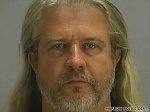 Not identifying this man’s race incorrectly leaves the impression that everyone is white, unless otherwise stated.
Not identifying this man’s race incorrectly leaves the impression that everyone is white, unless otherwise stated.
Gallery opening a success!
More than 50 people turned out Friday night for the opening of a new show of student work in the School of Journalim & Broadcasting Gallery. “American Dreams: Immigrants and Refugees in Bowling Green” features the work of my students in the Fleischaker-Greene Scholars class from the Spring 2009 semester.
I am really proud of the students for all their hard work. Please visit our Web site, www.fgscholars.com, for all the stories, photos and videos. And stop by the gallery on the first floor of MMTH to see the show, which will stay up at least through the end of September.
Special thanks to the WKU Honors College and the Fleischaker-Greene Fund for supporting this project.
Posted in Uncategorized
Breaking news in Steve Nunn case
In class today, we discussed the sad saga of former Kentucky legislator Steve Nunn, who had been arrested recently following the shooting death of his ex-fiancee outside her Lexington apartment.
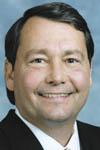 Nunn was not originally charged in the murder case. Instead, he was arrested for wanton endangerment for allegedly brandishing a gun at police as they arrested him at his parents’ gravesite in Hart County.
Nunn was not originally charged in the murder case. Instead, he was arrested for wanton endangerment for allegedly brandishing a gun at police as they arrested him at his parents’ gravesite in Hart County.
Today’s Bowling Green Daily News reports that Nunn has now been charged with the murder of Amanda Ross.
Local TV station WBKO had more details in the 6 p.m. newscast, which said:
In the arrest warrant, authorities say on the way to the hospital, Nunn said he was “sorry for not completing the job,” and he spoke of revenge. …
According to the warrant, police say Nunn told them he had lost his job, money and had been a burden to his family–just a few reasons that could’ve pushed Nunn to murder.
The station also posted a copy of the arrest warrant on its Web site. The document reveals a good deal more than either media outlet reported. According to the document:
- For several days before the incident, Nunn was depressed and speaking about death. He also asked his ex-wife to come take care of their children.
- After being discovered at the cemetery and arrested, Nunn spoke of going to the penitentiary.
- Police found a seven-page letter in Nunn’s car at the scene that addressed his legal problems with his ex-fiancee, spoke of her in derogatory terms, and talked of revenge.
- A credit card in Nunn’s wallet was used at 6:50 a.m. on Friday, 15 minutes after the murder, in Versailles, Ky., which is on a direct route between Lexington and the cemetery where Nunn was found.
- Police reported that “steps were taken to obscure the identity of the car.”
- Preliminary ballistic reports show that Ross was shot with a .38 special caliber weapon. The gun Nunn was found with was a .38 special revolver.
This should serve as a reminder to journalism students: Get the public records associated with stories you are reporting. They are a rich source of details, and they serve as the official documentation.



